

With its innovative features, Salesforce occupies a leading position in the vast market of customer relationship management tools. However, what makes it truly exceptional is more than its robust features and intuitive interface; it’s the ability of Salesforce to integrate seamlessly with a plethora of tools and platforms.
Each new tool you integrate with Salesforce adds a unique layer of functionality to your CRM experience. From streamlining workflows to unlocking deep insights, the right Salesforce integrations can drastically simplify your day-to-day work life.
In this blog, we will explore the best Salesforce integrations.
What Should You Look for in Salesforce Integrations?
Here are the things you should look for in Salesforce CRM integrations:
- Compatibility: Compatibility issues can lead to technical headaches and make the data integration ineffective. Therefore, ensure that the tool you’re choosing to integrate is compatible with your Salesforce instance and any other tools and data sources you’re currently using for customer data and email marketing
- Features: Evaluate the Salesforce integration and determine whether it addresses your specific needs and CRM strategy. Some features you should look for include user-friendly workflows, easy data integration, data accuracy, data synchronization, enhanced reporting capabilities, etc.
- Ease of use: A complicated or overly technical system integration can lead to frustration and resistance from Salesforce users in your organization. Therefore, choose apps that are user-friendly and intuitive, requiring minimal training for your team
- Customization: Seek Salesforce integration with tools that let you tailor the solution to your unique requirements. The ability to customize fields, workflows, and user interfaces ensures that the integration adapts to your business processes
- Reliability and support: Choose Salesforce integrations from reputable vendors with a track record of reliability and excellent customer support. Look for reviews and testimonials from other users to determine the vendor’s reputation and responsiveness to customer inquiries and issues
- Cost-effectiveness: Evaluate the cost-effectiveness of the Salesforce integrations in terms of its upfront cost, ongoing maintenance fees, and potential return on investment. You may need to also include the cost of any Salesforce integration services you choose to use.
The 10 Best Salesforce Integrations to Use in 2024
The best Salesforce integrations can take your experience and productivity to the next level. Let’s explore the 10 best integrations to use in 2024:
1. ClickUp
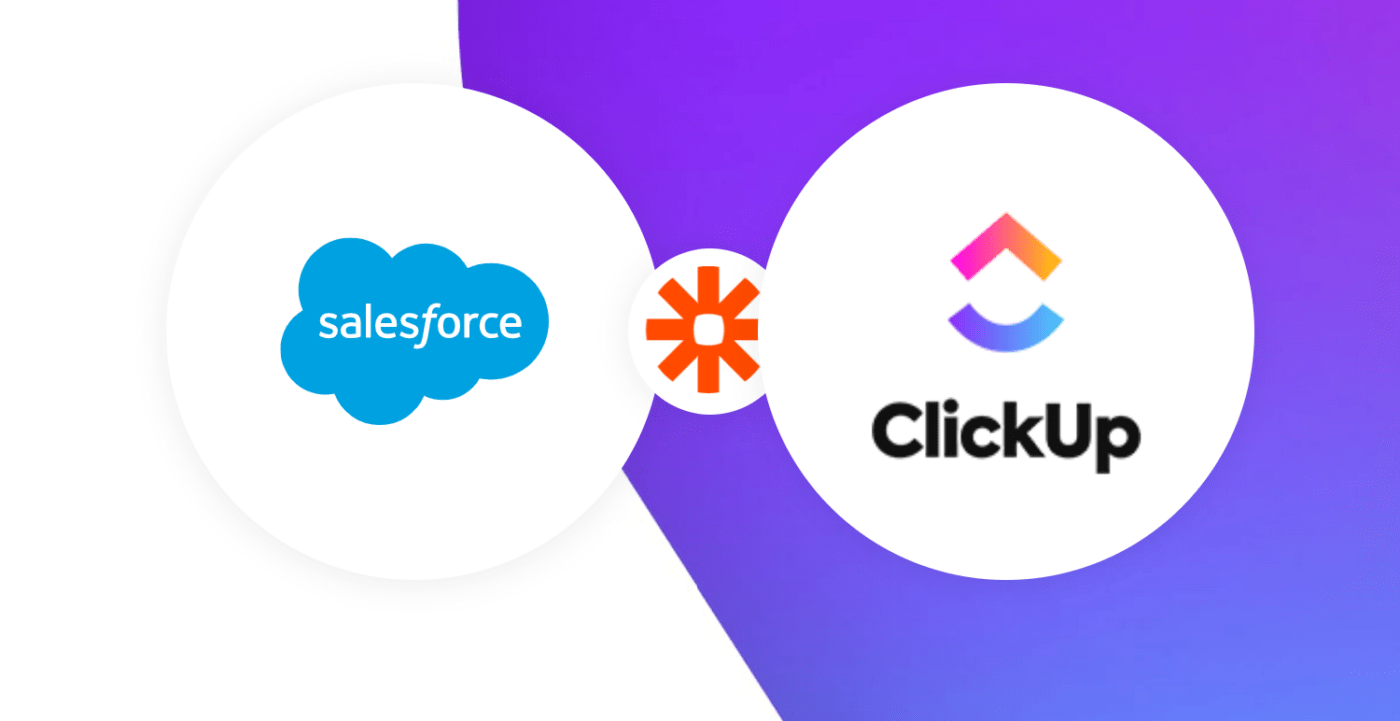
As an all-in-one productivity and project management platform, ClickUp aims to make the world more productive. To achieve this mission, it offers over 1,000 integrations, 15+ customizable views, and a robust set of collaborative features to streamline your workflows.
ClickUp’s Salesforce integration using Zapier allows you to automatically sync an action on any of the two platforms with each other. So, if you create an opportunity in Salesforce, ClickUp will automatically create a task for it.

ClickUp’s CRM capabilities enable managing client relationships with 15+ customizable views. You can visualize, monitor, and analyze data like customer lifetime value and average deal sizes in one place.
Using task relationships and custom fields in ClickUp, you can set up automatic workflows for task assignment, lead allocation, customer follow-ups, and more.
Further, you can eliminate silos and fast-track communication by centralizing customer information and outreach, making ClickUp a perfect Salesforce alternative.
But if you don’t want to switch over, you can still enjoy all the awesome features of ClickUp with Salesforce with minimal effort.
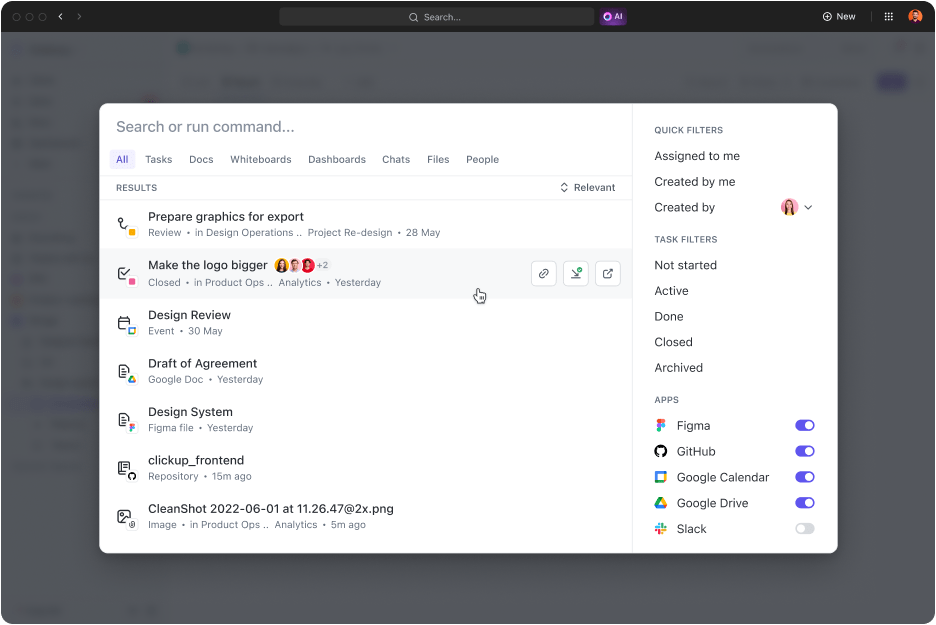
ClickUp’s Universal Search feature lets you search any file in ClickUp, all the connected apps (including Salesforce), and your local drive quickly and efficiently. You can add custom search commands and get better and more personalized results with continuous usage.
ClickUp best features
- Build a centralized database of all the customer information and view it conveniently using the Table View in ClickUp, with filters and groups to sort through information quickly
- Effortlessly sync ClickUp and Salesforce data and use Universal Search to find details in both with just a couple of clicks
- Get a clear overview of your sales pipeline, customer relationships, etc., using customizable ClickUp Dashboards
- Benefit from its collaborative CRM features that enable cross-departmental communication and workflow automation
- Organize information the way you want with Custom Fields, link customers with their purchase data and other details using Relationships in ClickUp
- Automatically assign tasks and clients to individuals based on specific fields using ClickUp Automation and trigger actions by due date or task status
- Automate outreach and follow-up tasks with ClickUp Brain by using it to write emails and create automated follow-ups for prospective customers
- Leverage free CRM templates for organizing your leads
ClickUp limitations
- Some users have complained about slow response times for complex tasks
- The wealth of features can be overwhelming initially
ClickUp pricing
- Free Forever
- Unlimited: $7/month per user
- Business: $12/month per user
- Enterprise: Contact for pricing
- ClickUp Brain: Add to any paid plan for $5 per Workspace member per month
ClickUp ratings and reviews
- G2: 4.7/5 (9,000+ reviews)
- Capterra: 4.7/5 (4,000+ reviews)
2. HubSpot

The HubSpot platform offers software solutions to integrate with your sales, support, marketing, and operations teams. You can connect your organization’s data sources, teams, and customers through this CRM software.
HubSpot has tools for social media and content management, along with SEO and web analytics solutions. Their Salesforce integration feature ensures your marketing, sales, and service teams work seamlessly. You can transfer data quickly, get comprehensive insights into your company metrics, and enable better collaboration, both internal and external.
HubSpot best features
- Enable better collaboration between marketing and sales teams
- Seamlessly sync and transfer Salesforce data between the two platforms
- Easily route and distribute new leads to sales reps and track their status in real time
- Gain actionable insights into your customers based on their interactions and preferences
- Customize record syncing
- Use HubSpot-Salesforce data integration to send personalized emails and segment your database
- Track revenue from deals and campaigns
HubSpot limitations
- Some users have asked for more customization between marketing and sales hub
- Many users have requested better features like more plugins, global backup or rollback options, more functionalities for the membership area, built-in e-commerce tools, and so on
HubSpot pricing
HubSpot Marketing Hub has the following pricing structure:
- Free
- Starter: $20/month per seat
- Professional: $890/month for 3 seats
- Enterprise: $3600/month for 5 seats
HubSpot ratings and reviews
- G2: 4.4/5 (10,800+ reviews)
- Capterra: 4.5/5 (5,800+ reviews)
3. Slack

Slack is among the most popular messaging apps for internal communications. It reduces the need for teams to communicate through emails or meetings through its expansive features like direct messaging, video and voice calls, groups, file-sharing, etc.
Integrating Slack with Salesforce helps with better collaboration among teams. You can share Salesforce records, enable real-time messaging, get Slack notifications about updates in Salesforce, and more.
Slack best features
- Get Slack notifications about new opportunities in Salesforce and view Salesforce records in Slack channels
- Communicate between Slack and Salesforce Chatter
- Set up alerts in Slack channels based on new Salesforce records being created or changes being made to existing records
- Collaborate with all teams through real-time updates on Salesforce records
- Integrate Salesforce records in Slack through the Slack Connect feature for external support team operations
- Display relevant Slack messages in Salesforce records
– Slack limitations
- Some users found the search feature inadequate
- The notifications can be overwhelming
Slack pricing
- Free
- Pro: $8.75/month per user
- Business: $15/month per user
- Enterprise Grid: Custom pricing
Slack AI is available at a custom price as an add-on for all plans
Slack ratings and reviews
- G2: 4.5/5 (32,400+ reviews)
- Capterra: 4.7/5 (23,100+ reviews)
4. LinkedIn Ads

As part of LinkedIn Marketing Solutions, LinkedIn Ads is ideal for developing a relationship with a professional audience. The platform offers in-depth audience insights to track engagement, build campaign targeting, and tap into various ad formats.
You can integrate LinkedIn Lead Gen advertisements with Salesforce’s Sales Cloud to enhance your lead generation strategy with a few basic setup steps. By integrating Salesforce with LinkedIn Ads with the help of Zapier, you can set up automation to route and manage leads, create new Salesforce leads from LinkedIn ad responses, and more.
LinkedIn Ads best features
- Add new LinkedIn Ads conversions as Salesforce leads
- Choose among various ad formats, including sponsored content, sponsored messaging, dynamic ads, and text ads
- Reach the right audience using LinkedIn Ads’ targeting tools
- Use analytics to track metrics and improve your campaign
- Add new Salesforce records to LinkedIn Ads audience as contacts
- Create and update records in Salesforce based on responses on LinkedIn
- Add custom records to Salesforce and even send Slack messages with the new LinkedIn Ads responses
LinkedIn Ads limitations
- You cannot target specific geographic areas for ads
- Some users found the platform expensive
LinkedIn Ads pricing
- LinkedIn Ads offers custom pricing.
LinkedIn Ads ratings and reviews
- G2: 4/5 (250+ reviews)
- Capterra: 4.6/5 (10+ reviews)
5. Gmail
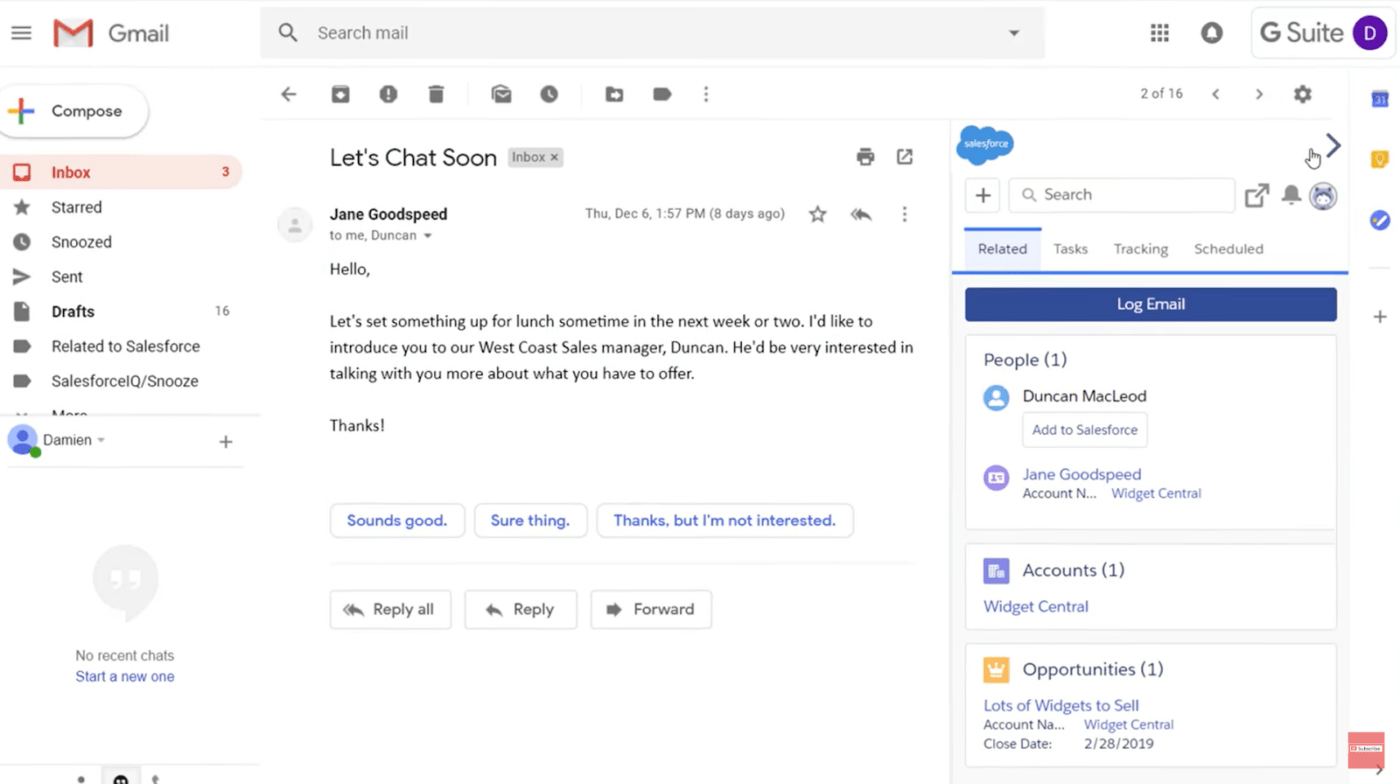
As one of the world’s most popular email services, Gmail offers its users many benefits, such as security, Smart Compose, quick replies, and an easy-to-use interface. Connecting Gmail to Salesforce can boost productivity and keep all your email communications in sync.
This integration allows you to view and manage Salesforce data directly in the Gmail platform, create Salesforce records quickly, and log the emails back to Salesforce without involving any manual data entry.
Gmail best features
- Attach email messages or calendar entries to Salesforce records
- Create Salesforce leads directly from your inbox
- Use Salesforce email templates to create or reply to messages
- Add new unrecognized contacts from an email to Salesforce records directly
- Avoid switching between Gmail and Salesforce due to centralized access to emails and Salesforce records
- Access Salesforce tasks and change their status through Gmail
Gmail limitations
- The design hasn’t been significantly improved in a while
- It offers limited storage space for free
Gmail pricing
Gmail is available as a free service. However, if you want a professional email address and custom branding options, you can buy Google Workspace plans, which are as follows:
- Business Starter: $6/month per user
- Business Standard: $12/month per user
- Business Plus: $18/month per user
- Enterprise: Custom pricing
Gmail ratings and reviews
- G2: 4.6/5 (42,000+ reviews) (Workspace)
- Capterra: 4.8/5 (12,200+ reviews)
6. Mailchimp
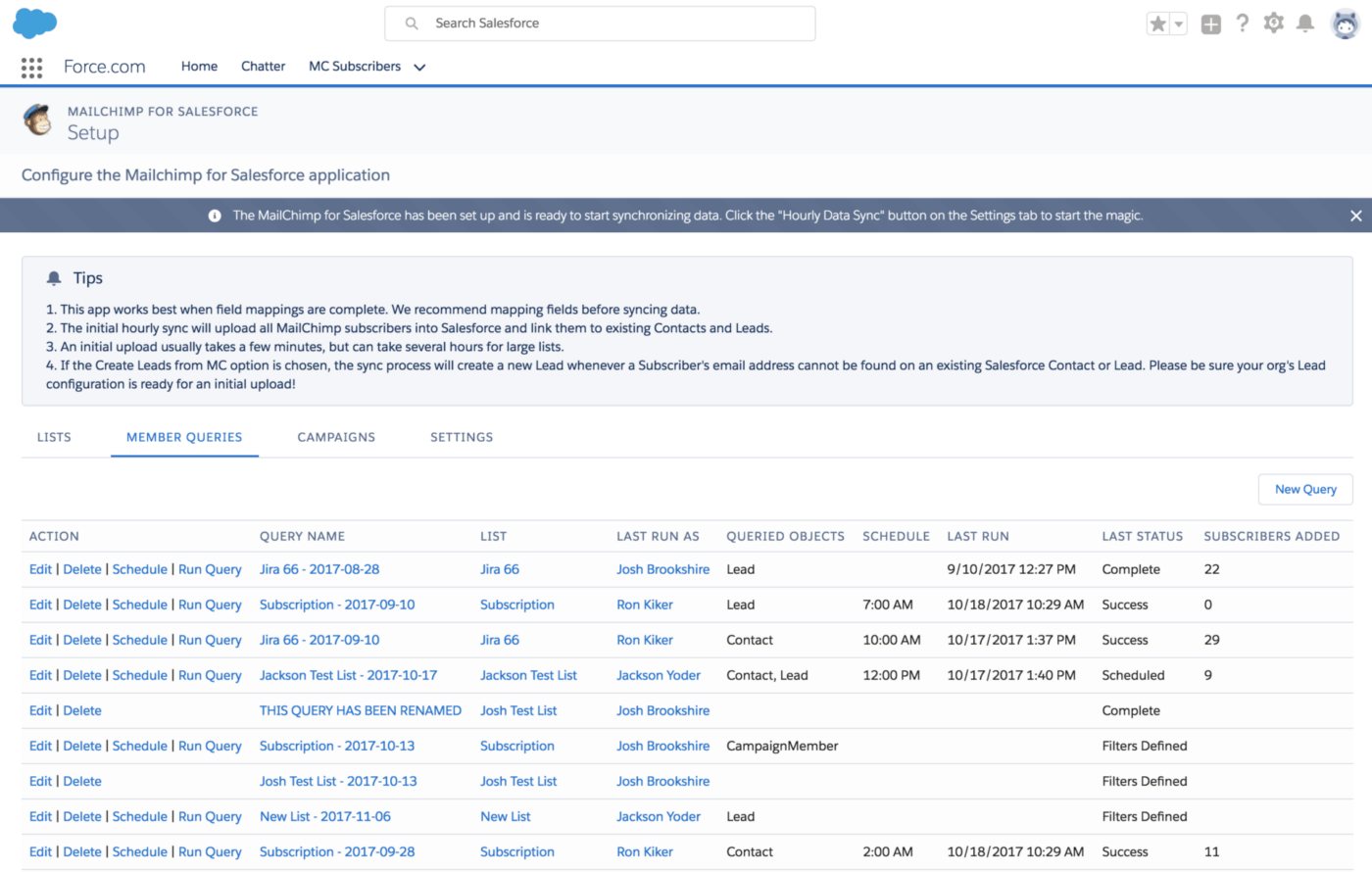
Mailchimp is an email marketing platform that lets you design, send, and track email campaigns. You can analyze campaign performance, convert more customers, set up automated email sequences, and do more with the platform.
You can sync your Salesforce account data with Mailchimp by integrating Salesforce with Mailchimp. This lets you quickly share all sales leads and contacts, target your leads with specialized email campaigns, and use data to build Mailchimp segments. You can also sync subscribers between both platforms.
Mailchimp best features
- Import contacts, leads, and subscribers from Salesforce
- Streamline communication by using Mailchimp subscribers as Salesforce leads
- Customize the application to manage data and user access
- Use valuable insights from one tool to improve performance in the other
- Customize the page, contact, and lead layout
Mailchimp limitations
- The free plan has very restrictive email and subscriber limits
- Some users found the design functionality limited
Mailchimp pricing
- Free
- Essentials: $9.17/month
- Standard: $13.70/month
- Premium: $273.92/month
*The pricing is for 500 contacts. The rate increases with an increase in the number of contacts.
Mailchimp ratings and reviews
- G2: 4.4/5 (5,100+ reviews)
- Capterra: 4.4/5 (16,800+ reviews)
7. Gravity Forms
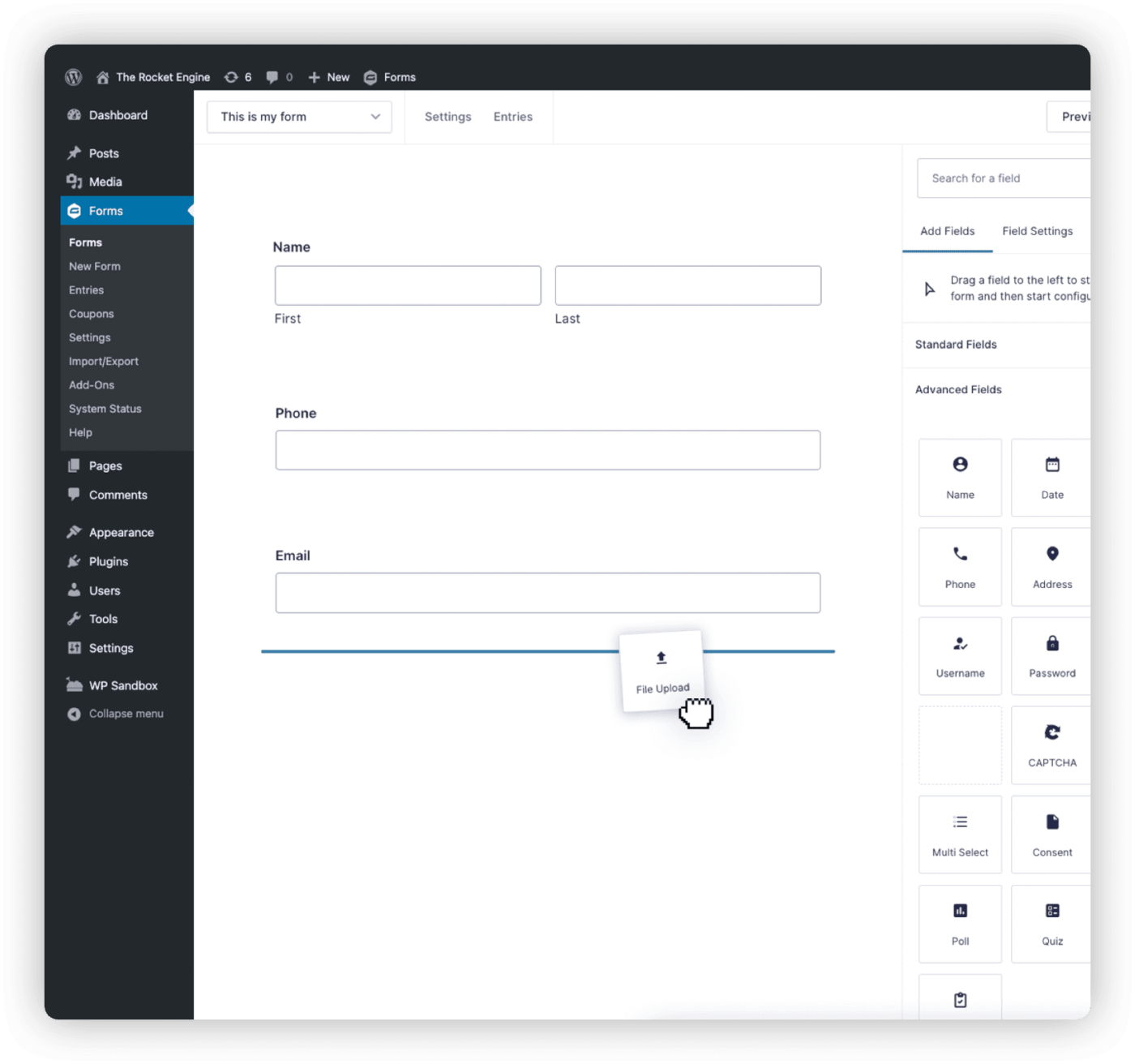
Gravity Forms is a form creation software that helps customize online forms and workflows in WordPress. You can create forms to capture leads, automate workflows, and collect payments.
With Salesforce-Gravity Forms integration, you can connect the Salesforce CRM with WordPress Gravity Forms. This allows you to automatically add and update Gravity Forms form submissions to your Salesforce account for better lead management and data collection, improved reporting and analytics, scalability, and personalization.
Gravity Forms best features
- Integrate the Gravity Forms form with Salesforce Lead, Contact, or Case
- Create forms efficiently using the drag-and-drop form builder
- Build highly accessible forms
- Conduct surveys, feedback, and registrations easily
- Solve complex use cases with conditional logic
Gravity Forms limitations
- The free version offers limited features
- Users find the interface clunky and dated
Gravity Forms pricing
- Basic License: $59 (billed annually)
- Pro License: $159 (billed annually)
- Elite License: $259 (billed annually)
- Nonprofit License: $129 (billed annually)
Gravity Forms ratings and reviews
- G2: 4.7/5 (230+ reviews)
- Capterra: 4.7/5 (70+ reviews)
8. Typeform
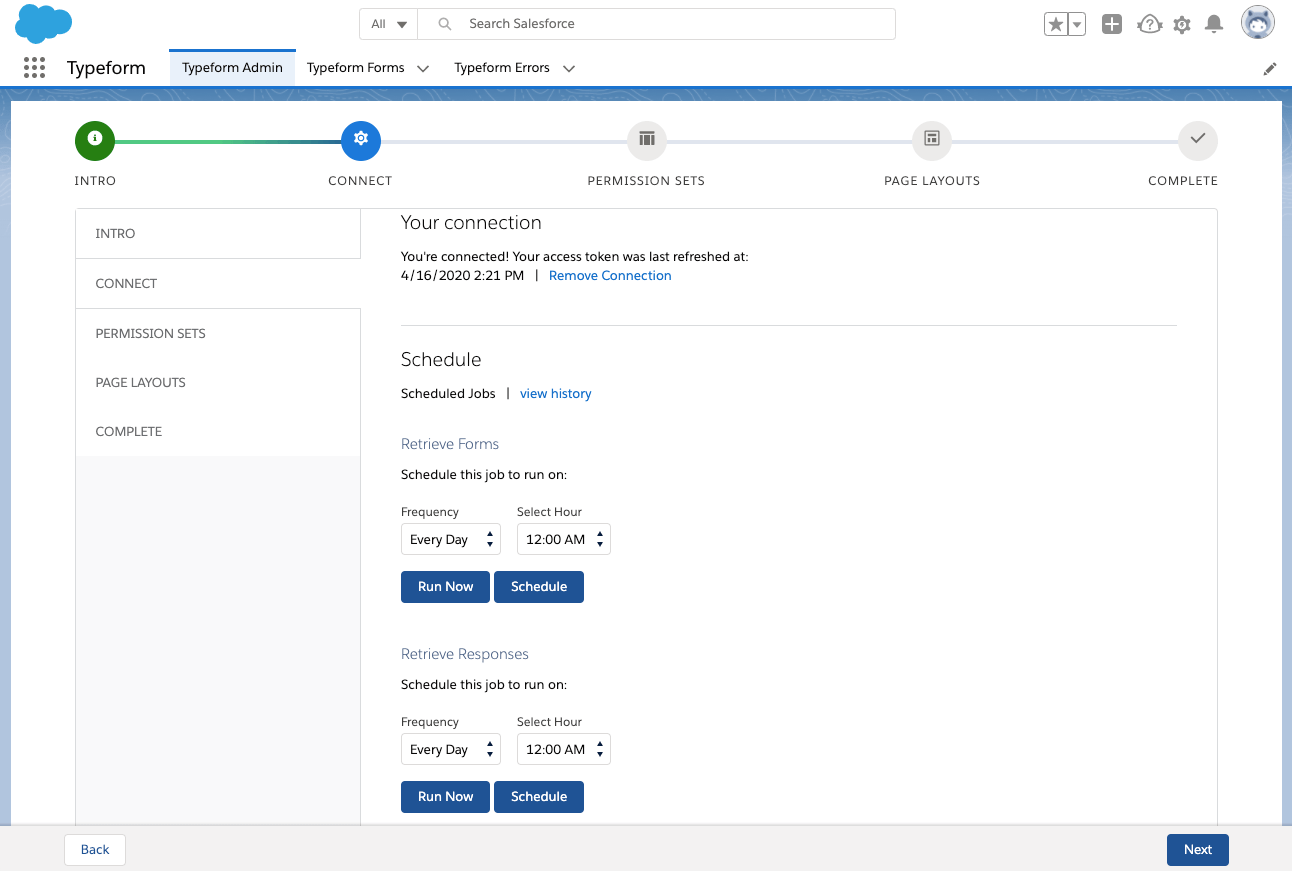
Typeform is a survey builder tool that helps create striking forms for signups, feedback, research, and any other purpose you can think of. It helps in collecting data efficiently through embedded forms and integration with the platforms you use regularly.
Integrating Typeform with Salesforce lets you automatically map Typeform fields whenever your form is submitted. Work with an easy-to-use interface to create different forms and quickly generate leads.
Typeform best features
- Create forms, surveys, and quizzes
- Sync the list of forms available in Typeform and the responses from these forms with Salesforce data
- Map Typeforms to Salesforce objects like Lead, Opportunity, Contact, Account, and Case
- Customize the frequency of Salesforce data/responses sync with Typeform
- Manage customer support tickets and run marketing campaigns with centralized data
Typeform limitations
- The Salesforce integration is only available in the Business plan
- Some users found the tool a bit pricey
Typeform pricing
- Free
- Basic: $29/month
- Plus: $59/month
- Business: $99/month
- Enterprise: Custom pricing
Typeform ratings and reviews
- G2: 4.5/5 (700+ reviews)
- Capterra: 4.7/5 (830+ reviews)
9. Calendly

Calendly is a scheduling automation platform perfect for teams that conduct frequent meetings. It eliminates the need for back-and-forth in emails and saves valuable time. No wonder, then, that this is among the popular Salesforce integrations for the sales team of any company.
The Calendly-Salesforce integration eliminates the need to update Salesforce manually and lets you focus more on your customers. Calendly automatically creates a new Lead, Contact, or Opportunity in Salesforce when you schedule new meetings. This way, you can close deals more efficiently and schedule high-value leads on the spot. With Calendly Routing, you can qualify, route, and manage meetings, events, seminars, and appointments with the help of your marketing forms and directly from Salesforce records.
Calendly best features
- Automatically add Calendly meetings to an existing Salesforce record or create a new one
- Get accurate and updated data from Calendly directly in Salesforce
- Sync Calendly data for specific groups to avoid confusion and keep irrelevant data out of Salesforce
- View upcoming and past meetings from Salesforce
- Track and measure activity from Calendly
Calendly limitations
- Only available on Teams and Enterprise plans
Calendly pricing
- Free
- Standard: $12/month per seat
- Teams: $20/month per seat
- Enterprise: Starts at $15,000/year
Calendly ratings and reviews
- G2: 4.7/5 (2,100+ reviews)
- Capterra: 4.7/5 (3,400+ reviews)
10. Eventbrite

Eventbrite is an event management platform that lets you create customizable event pages, market events, and sell tickets. It also helps in user registration, payment processing, email automation and customization, and social media promotion. It is among the popular Salesforce integrations for event-based marketing.
Integrating Eventbrite with the Salesforce platform lets you sync event, order, and attendee data between the two tools. The integration will automatically create Leads, Contacts, and Accounts based on the list of attendees from Eventbrite.
Eventbrite best features
- View and track all event data on Salesforce
- Create meaningful reports using event and Salesforce data integration
- Get notifications whenever a new Salesforce lead is created
- Map attendee fields from Eventbrite to Leads and Contacts from Salesforce
Eventbrite limitations
- Some users found the customer support unresponsive
- It lacks customization
Eventbrite pricing
- Free: For up to 25 tickets
- Flex: $9.99/event for up to 100 tickets
- Pro: $29/month for up to 100 tickets
- Premium: Custom pricing
Eventbrite ratings and reviews
- G2: 4.3/5 (760+ reviews)
- Capterra: 4.6/5 (4,900+ reviews)
Elevate Your Salesforce Experience with ClickUp!
With its innovative features, Salesforce has become a favorite of sales and marketing teams in countless organizations. The Salesforce integrations we’ve included here will help you get more out of your Salesforce experience, skyrocketing your productivity and efficiency.
Choose the Salesforce integration that best matches your needs. For example, if you need a CRM alternative or a marketing automation tool, HubSpot or LinkedIn Ads are best. Gmail and Mailchimp will suit you better if you need Salesforce apps to manage your emails.
However, if you are looking for the best Salesforce integration that suits all your needs and connects disparate systems, try ClickUp. It works as a collaboration, CRM, and customer database software—an all-in-one solution with powerful features. Give it a go by signing up for free!



